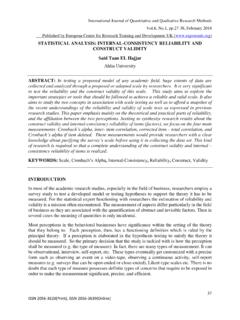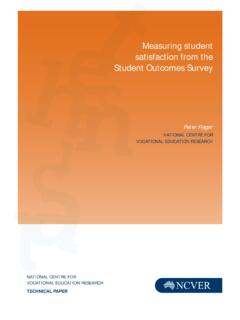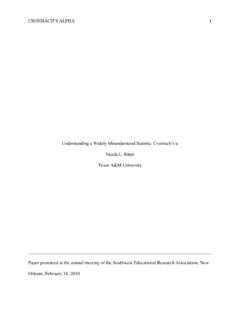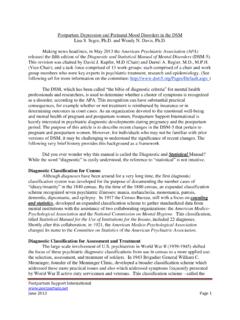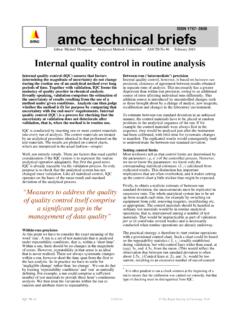Transcription of Statistical considerations in confirmatory clinical trials II
1 Session 4: Statistical considerations in confirmatory clinical trials II Agenda Interim analysis data monitoring committees group sequential designs Adaptive designs sample size re-estimation Phase II/III trials Subgroup analyses exploratory and confirmatory Missing data 2 Interim analysis Trial design with an interim analysis Unblinded interim analysis : Any review of data requiring patients to be grouped according to the randomisation before the database is frozen Unblinded interim analysis conducted to: Assess whether to stop study early due Safety concerns Efficacy (overwhelmingly positive results) Futility Adapt the study design ( choose between doses) Planning other studies (not recommended for confirmatory studies) Blinded interim analysis : no grouping of treatments according to randomisation Monitor total number of clinical events Review ongoing safety data 4 Maintain study blind Need to maintain blind among people directly involved in the study Study staff Investigators Sponsor staff directly involved in the trial May require evaluation of interim analysis by independent data monitoring committee (IDMC).
2 5 IDMC for confirmatory trials Independent of investigators, sponsor involvement discouraged Includes clinical experts in the therapeutic area and a statistician Safety monitoring primary responsibility, may monitor efficacy Makes recommendations that impact the future conduct of the trial, include continuing, terminating or modifications to the trial Implementation of IDMC recommendation is responsibility of the sponsor Possible to ignore recommendations 6 7 Sponsor Designs the trial with steering committee Interactions with regulators ensures flow of high quality data Independent Data Monitoring Committee: Reviews interim analysis and makes recommendation to SC Statistical Data analysis Centre Performs interim analyses Steering Committee: Makes important decisions regarding the trial Responsible for trial integrity Committees for a large trial Interim analysis for efficacy Allows trial to stop early for overwhelming efficacy May be necessary for serious outcomes to avoid unnecessary placebo exposure Can mean medicine available to patients earlier Risks with stopping early include: Reduction in available safety database.
3 Increased variability in estimates of treatment effects. Reduced information on secondary endpoints Acceptance of study results is not only based on a statistically significant primary result May need sufficient data to explore important subgroups 8 consistency of results Regulators interested in assessing results before and after interim analysis Substantial discrepancies with respect to the types of patients recruited and / or results obtained will raise concern Difficult to interpret conclusions if it is suspected that the observed discrepancies are a consequence of dissemination of the interim results. Difficult to convincingly demonstrate that no unblinded interim results have been released. Differences between stages can occur by chance so Interim analyses always introduce this risk 9 P-value adjustment If the interim analysis can only stop the trial for safety or futility, no p-value adjustment required Need to make this clear in the protocol If interim analysis can stop for efficacy, then need to adjust for more than one look at the data If there is truly no difference between treatments, have more than one chance a false positive Need to control overall probability of a false positive If study stops for efficacy at interim there is a sample size saving compared to a fixed sample size study But if the trial continues to completion.
4 Sample size is larger because of p-value adjustment 10 Group-sequential design Conduct one or more interim analyses during the course of a study. Two possible decisions after each interim analysis : Continue the trial as planned. Terminate the trial Control overall Type I error rate. Construct stopping boundaries that enable the trial to stop early if there is overwhelming evidence of efficacy, Maximum sample size (sponsor commitment) is known up front O Brien/Fleming approach typical option as the penalty for conducting interim analyses is small. Generally well accepted by Regulatory authorities. 11 Benefits & limitations of group sequential Benefits Very well established methodology. Understood and accepted by regulators (ICH-E9).
5 Allows the flexibility to stop early for efficacy Can vary timing and number of interim analyses Limitations Interim analysis performed on the same endpoint at interim and final Design focus is on maximum sample size, fixed in advance Can t amend the design to drop treatments or doses 12 TORCH trial 13 TORCH trial Trial comparing mortality in COPD Independent IDMC Interim analysis for safety every 6 months Two formal efficacy interim analyses Final analysis Unadjusted p-value Adjusted p-value 14 Adaptive Designs Definition Adaptive Design any design which uses an interim analysis to modify aspects of the design ( sample-size, number of treatment arms) Type of design modification has to be pre-specified in the protocol Requires control of the type I error for regulatory purposes Requires assessment of homogeneity of results from different stages Need to justify combining results from different stages 16 Sample size re-estimation Uncertainty about sample size assumptions.
6 Size of placebo effect Whenever possible, use blinded sample size reassessment total number of events Need to pre-specify size of treatment effect to be detected If based on unblinded analysis , need to show control of type I error 17 Interim analysis Sample size Re-estimation Active Control Sample size re-estimation enrollment Final sample size initial sample size 18 Group sequential vs. adaptive Group sequential design: focus is on maximum sample size Plan larger trial, stop early if unexpected large efficacy More statistically efficient Adaptive design: focus is on initial sample size Start smaller, expand if need to More complex analysis may be required 19 Standard 2 phases Adaptive Seamless Design Plan & Design Phase III Dose Selection Learning A B C D Control A B C D Control Confirming Learning, Selecting and Confirming Plan & Design Phase IIb Plan & Design Phase IIb and III Phase II / III trials 20 Phase II / III trials Initially investigate multiple doses of experimental treatment Select dose to take forward based on interim analysis Only continue this dose and placebo for rest of study Requires careful control of type I error Can use short term endpoint for dose selection.
7 Longer term endpoint for confirmatory part of the trial 21 Indacaterol trial Stage I (N = 115 per group, 7 groups) 75, 150, 300, 600 mg indacaterol vs placebo vs formoterol vs tiotropium Interim based on 2 week efficacy outcome two doses selected for to Stage 2 lowest dose meeting pre-defined efficacy criterion + next dose Final analysis performed after 26 weeks Careful control of type I error Second conventional phase III trial started in parallel after interim analysis 23 Phase II / III trials Other option, non-inferentially seamless Two part protocol, Part A decides dose Part B is confirmatory study but doesn t use data from Part A in analysis Avoids need for unblinded interim and alpha adjustment 24 Phase II/III trials Advantages of adaptive seamless designs Increase of information value per patient Shorter overall development time Issues Number of treatment groups can change during trial with resulting implications in drug supply Careful consideration of trial integrity issues (unblinding, consistency between stages)
8 Use of phase II/III designs misses opportunity to discuss/agree dose with regulatory authorities end-of-phase II or CHMP advice 25 Subgroup analysis confirmatory subgroup analysis Generally requires pre-specification that a subgroup is expected to have larger effect Usually expected in the context of an overall positive trial Not usually possible to rescue a trial with overall non-positive result 27 Subgroup analysis Overall concern that the response of the average patient may not be the response of the all patients in the study Routine requirement for analysis by subgroup Aim Identify patient groups with differential treatment effects Assessment of internal consistency Licence can be restricted if not sufficient evidence of a positive risk-benefit in the subgroup 28 Typical list of subgroups for analysis Sex Age Race Region Baseline severity measure 1 Baseline severity measure 2 clinical events in the previous year Baseline medication Baseline blood biomarker 29 Multiplicity Results from analyses are interpreted as the true results for that group of patients Subgroup differences in treatment effect can arise by chance Hard to identify what is a true difference Single subgroup with 5 levels, equal n, 90% power to detect overall effect* No true difference among subgroups Probability of observing at least one negative subgroup result = 32% * Li Z, Chuang-Stein C, Hoseyni C.
9 Drug Inf J. 2007;41(1):47 56 30 Classic example of dangers ISIS-2 trial aspirin vs placebo for vascular deaths Overall trial extremely positive for reduction in mortality Subgroup analysis by star sign Gemini or Libra: adverse effect of aspirin on mortality Remaining star signs: highly significant effect of aspirin on mortality ISIS-2 . Lancet 1988; 332:349-360 31 Multiplicity: is the difference real? Biological plausibility Pre-definition Differential effect anticipated Plausible but not anticipated Not plausible, hypothesis generating consistency across endpoints Replication across two trials But meta- analysis can still have subgroup problems 32 Design assumption Frequent assumption (by sponsors): patient population is homogeneous Pragmatic approach for sample size determination Should expect a consistent treatment effect Anything else due to chance Alternative assumption (by regulators): treatment effect will vary between subgroups Burden of proof to establish an effect in each heterogeneous subgroup is with the trial sponsor 33 Can we limit the number of subgroups?
10 Design stage, pre-specification Scientific rationale for heterogeneous effects? Should separate trials be performed? Pre-agreement with regulatory authorities on important subgroups may be helpful Need for subgroup analysis is related to the overall patient population Sponsors may identify targeted populations The more homogeneous the population studied, the fewer requirements there should be for subgroup analyses 34 How to assess results? Tests for interaction of limited value when investigating subgroup differences Low power to detect heterogeneity Still have 5% or 10% false positive rate Hypothesis testing not appropriate Estimates and CI of size of










